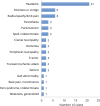Synchronous neurology-primary care collaboration in a medical home
- PMID: 33299666
- PMCID: PMC7717639
- DOI: 10.1212/CPJ.0000000000000754
Synchronous neurology-primary care collaboration in a medical home
Abstract
Background: Synchronous collaboration as defined by a simultaneous encounter between primary care providers (PCPs), patients, and neurologists may improve access to neurologic expertise, care value, and satisfaction of PCPs and patients. We examined a series of synchronous collaborations and report outcomes, PCP satisfaction, downstream utilization, and illustrative case examples.
Methods: Within an outpatient collaborative primary care-neurology care model, we implemented synchronous video consultations from a central hub to satellite clinics while increasing availability of synchronous telephone and face-to-face collaboration. PCP experience was assessed by a postcollaboration survey. Individual cases were summarized. Clinical and utilization outcomes were assessed by a neurologist immediately after and by follow-up chart review.
Results: A total of 58 total synchronous collaborations were performed: 30 by telephone (52%), 18 face to face (31%), and 10 by video (17%) over 27 clinic half-days. The most frequent outcomes as assessed by the neurologist were reassurance of the PCP (23/58; 40%) and patient (22/59; 38%), and the neurologist changed the treatment plan (23/58; 40%). A subsequent face-to-face consultation was completed in 15% (6/58) of patients initially assessed by telephone or video. Test utilization was avoided in 40% (23/58). Unintended utilization occurred 9% (5/58). Most PCPs were very satisfied with the ease of access, quality of care, and reported high likelihood of subsequent use. PCPs perceived similar or less time spent during synchronous vs asynchronous collaboration and neurologist usually altered the testing (87.8%) and treatment plan (95.2%).
Conclusions: Synchronous collaboration between neurologists and PCPs may improve timely access to neurologic expertise, downstream utilization, and PCP satisfaction.
© 2019 American Academy of Neurology.
Figures
Comment in
-
Robot doctors: Teleneurology pros and cons.Neurol Clin Pract. 2020 Oct;10(5):377-378. doi: 10.1212/CPJ.0000000000000757. Neurol Clin Pract. 2020. PMID: 33304645 Free PMC article. No abstract available.
References
-
- Young NP, Elrashidi MY, Crane SJ, Ebbert JO. Pilot of integrated, colocated neurology in a primary care medical home. J Eval Clin Pract 2017;23:548–553. - PubMed
-
- Demaerschalk BM, Levine SR. Telestroke: solid support for virtual acute stroke care. Neurology 2016;87:1314–1315. - PubMed
-
- Dumitrascu OM, Demaerschalk BM. Telestroke. Curr Cardiol Rep 2017;19:85. - PubMed
-
- Wechsler LR. Advantages and limitations of teleneurology. JAMA Neurol 2015;72:349–354. - PubMed
LinkOut - more resources
Full Text Sources


